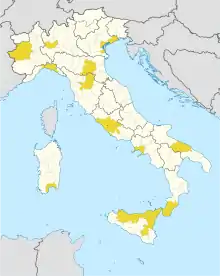Metropolitan cities of Italy
The metropolitan cities of Italy (Italian: città metropolitane d'Italia) are administrative divisions of Italy, operative since 2015, which are a special type of province. The metropolitan city, as defined by law, includes a large core city and the smaller surrounding towns that are closely related to it with regard to economic activities and essential public services, as well as to cultural relations and to territorial features.

History
The original 1990 law individuated as metropolitan cities the comuni of Turin, Milan, Venice, Genoa, Bologna, Florence, Rome, Bari, Naples and their respective hinterlands, reserving the autonomous regions the right to individuate metropolitan areas in their territory.[1] In 2009, amendments added Reggio Calabria to the list.[2] The metropolitan areas individuated by the autonomous regions were: Cagliari in Sardinia; Catania, Messina and Palermo in Sicily.
On 3 April 2014 the Italian Parliament approved a law that established 10 metropolitan cities in Italy,[3] excluding the autonomous regions. Four more were added later. The new metropolitan cities have been operative since 1 January 2015.
Government
A metropolitan city is composed of a central city, which serves as the seat of government, and its surrounding communes (comuni). Each metropolitan city is headed by a metropolitan mayor (sindaco metropolitano), who is assisted by a legislative body, the metropolitan council (consiglio metropolitano), and by a non-legislative assembly, the metropolitan conference (conferenza metropolitana).[4]
The metropolitan mayor is the chief executive and administrative officer of the city. The mayor represents, convenes and chairs meetings of the metropolitan council, administers city offices, supervises the functioning of city services, and prepares the city's budget.[4] The mayor of the provincial capital commune automatically becomes the metropolitan mayor.[4]
The metropolitan council is the chief legislative body of the metropolitan city. It proposes laws and amendments to the metropolitan conference, and approves programs, regulations and rules submitted to it by the metropolitan mayor such as the budget.[4] The council consists of mayors and city councillors of each commune in the metropolitan city elected from amongst themselves using partially open list proportional representation, with seats allocated using the D'Hondt method.[4] Metropolitan councillors are elected at-large for five-year terms; votes for metropolitan councillors are weighted by grouping communes of a certain population range into nine groups so that votes of the mayors and city councillors of the more populous groups are worth than those of less populous groups.[4] The number of councillors a metropolitan city is granted depends upon its population: metropolitan cities with a population of 3 million or more have 24 councillors; metropolitan cities with a population of 800,000 but less than or equal to 3 million have 18 councillors; all other metropolitan cities have 14 councillors.[4]
The metropolitan conference adopts or rejects laws and amendments approved by the metropolitan council. It is the ultimate approving body of the city's budget.[4] Actions in the conference require votes of at least two-thirds of communes in the metropolitan city and the majority of overall resident population. The conference is composed of all mayors of the communes within the metropolitan city.[4][5]
Functions
Metropolitan cities carry out the basic functions of a province. However, particular functions that devolved to them include but are not limited to:[4]
- local planning and zoning;
- provision of local police services;
- transport and city services coordination.
Metropolitan cities
| Metropolitan city | Area (km2) | Population (May 2020) |
Population Density (/km2) |
Date | Mayor |
|---|---|---|---|---|---|
| Rome (Roma) | 5,352 | 4,323,664 | 811 | 3 April 2014 | Virginia Raggi (M5S) |
| Milan (Milano) | 1,575 | 3,274,499 | 2,064 | 3 April 2014 | Giuseppe Sala (PD) |
| Naples (Napoli) | 1,171 | 3,076,675 | 2,634 | 3 April 2014 | Luigi De Magistris (DemA) |
| Turin (Torino) | 6,827 | 2,246,423 | 329 | 3 April 2014 | Chiara Appendino (M5S) |
| Bari | 3,821 | 1,245,558 | 328 | 3 April 2014 | Antonio Decaro (PD) |
| Palermo | 5,009 | 1,238,609 | 250 | 4 August 2015 | Leoluca Orlando (Independent) |
| Catania | 3,574 | 1,101,463 | 310 | 4 August 2015 | Salvo Pogliese (FI) |
| Bologna | 3,702 | 1,017,225 | 274 | 3 April 2014 | Virginio Merola (PD) |
| Florence (Firenze) | 3,514 | 1,000,111 | 288 | 3 April 2014 | Dario Nardella (PD) |
| Venice (Venezia) | 2,462 | 849,173 | 347 | 3 April 2014 | Luigi Brugnaro (Independent) |
| Genoa (Genova) | 1,839 | 831,786 | 457 | 3 April 2014 | Marco Bucci (FI) |
| Messina | 3,266 | 618,459 | 192 | 4 August 2015 | Cateno De Luca (UdC) |
| Reggio Calabria | 3,183 | 539,079 | 172 | 3 April 2014 | Giuseppe Falcomatà (PD) |
| Cagliari | 1,248 | 429,667 | 345 | 4 February 2016 | Massimo Zedda (Independent) |
References
- http://www.edscuola.it/archivio/norme/leggi/l142_90.html Law 8 June 1990 n. 142
- Law 5 May 2009 n. 42 Archived 27 September 2011 at the Wayback Machine
- http://www.ilsole24ore.com/art/notizie/2014-04-03/addio-vecchie-provice-e-legge-ddl-delrio-144336.shtml?uuid=ABRoQ37
- "LEGGE 7 aprile 2014, n. 56" (PDF). ponmetro.it/. Pon Metro. Retrieved 13 August 2019.
- http://www.ilsole24ore.com/art/notizie/2014-04-03/citta-metropolitanei-nuovi-organi-203019.shtml?uuid=ABwmpA8&nmll=2707#navigation
External links
![]() Media related to Metropolitan cities of Italy at Wikimedia Commons
Media related to Metropolitan cities of Italy at Wikimedia Commons
